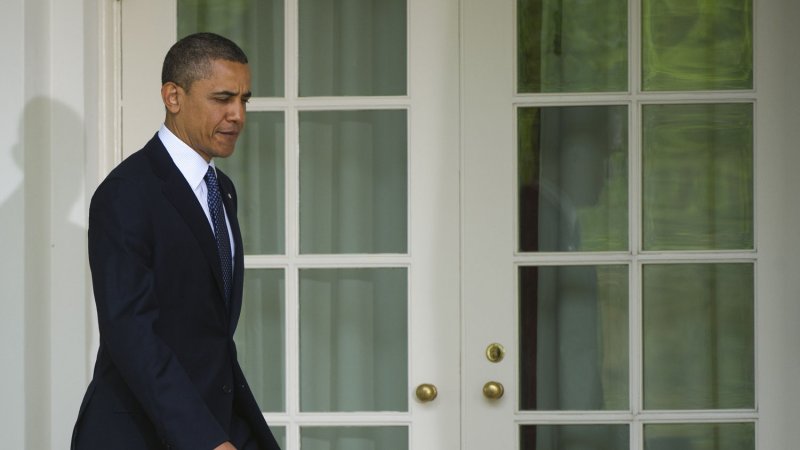U.S. President Barack Obama walks to a signing ceremony for the Jumpstart Our Business Startups (JOBS) Act, Act in the Rose Garden at the White House in Washington, D.C. on April 5, 2012. The JOBS Act includes key initiatives to help small businesses and startups grow and create jobs. UPI/Kevin Dietsch |
License Photo
COLLEGE PARK, Md., June 1 (UPI) -- The U.S. economy added only 69,000 jobs in May -- about half of what is needed to keep up with natural population growth. The unemployment rate rose to 8.2 percent.
In the weakest recovery since the Great Depression, nearly the entire reduction in unemployment since October 2009 has been accomplished through a significant drop in the percentage of adults working or looking for work. Some of these folks returned to the labor market in May. Consequently, unemployment ticked up 1-10th of a percentage point.
Growth slowed to 1.9 percent in the first quarter from 3 percent the previous period, and was largely sustained by consumers taking on more car and student loans, business investments in equipment and software and some inventory build. The housing market is improving and that should lift second quarter residential construction a bit but, overall, the economy and jobs growth should remain too slower to genuinely dent unemployment.
The May jobs report indicates growth could be even slower in the second quarter and the economy is dangerously close to stalling and falling into recession.
Manufacturing added 13,000 jobs. Other big gainers were healthcare, wholesale trade, and transportation and warehousing.
Construction lost about 28,000 jobs and other big losers were leisure and hospitality and state and local governments.
In other sectors, jobs gains were weak or small numbers of jobs were lost.
Gains in manufacturing production haven't instigated stronger improvements in employment largely because so much of the growth is focused in high-value activity. Assembly work, outside the auto patch, remains handicapped by the exchange rate situation with the Chinese yuan.
Recent moves by China to further weaken its currency and to close its markets to stimulate its own flagging demand indicate matters will get worse without a substantive response from Washington. Also, concerns about health insurance costs, once Obamacare is fully implemented, are discouraging employers.
The economic crisis in Europe and mounting problems in China's housing and banking sectors continue to instigate worries among U.S. businesses about a second major recession and these discourage new hiring. The U.S. economy continues to expand albeit moderately but is quite vulnerable to shock waves from crises in European and Asia.
Factoring in those discouraged adults and others working part time for lack of full time opportunities, the unemployment rate is about 14.8 percent. Adding college graduates in low-skill positions, like counterwork at Starbucks, and the unemployment rate is likely closer to 18 percent.
Prospects for lowering those dreadful statistics remain slim. The economy must add 13 million jobs over the next three years -- 362,000 each month -- to bring unemployment down to 6 percent.
Growth in the range of 4-5 percent is needed to get unemployment down to 6 percent over the next several years. In 2011, the economy grew only 1.7 percent but that is expected to expand less than 2.5 percent in 2012.
Growth is weak and jobs are in jeopardy because temporary tax cuts, stimulus spending, large federal deficits, expensive-but-ineffective business regulations and costly healthcare mandates don't address structural problems holding back dynamic growth and jobs creation -- the huge trade deficit and dysfunctional energy policies.
Oil and trade with China account for nearly the entire $600 billion trade deficit. Dollars sent abroad that don't return to purchase U.S. exports, are lost purchasing power. Consequently, the U.S. economy is expanding at 2 percent a year instead of the 5 percent pace that is possible after emerging from a deep recession and with such high unemployment.
Without prompt efforts to produce more domestic oil, redress the trade imbalance with China, relax burdensome business regulations, and curb healthcare mandates and costs, the U.S. economy cannot grow and create enough jobs.
--
(Peter Morici is an economist and professor at the Smith School of Business, University of Maryland School, and a widely published columnist.)
--
(United Press International's "Outside View" commentaries are written by outside contributors who specialize in a variety of important issues. The views expressed do not necessarily reflect those of United Press International. In the interests of creating an open forum, original submissions are invited.)















